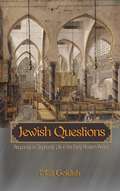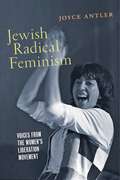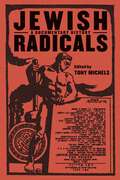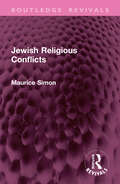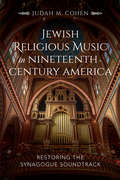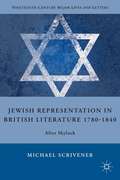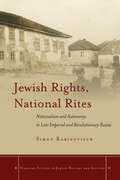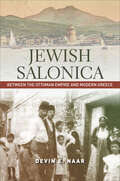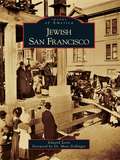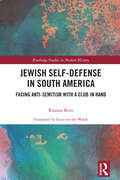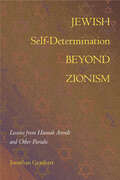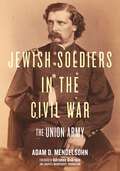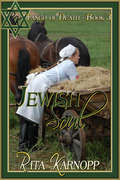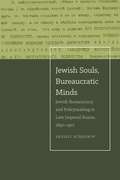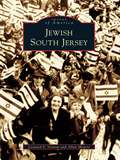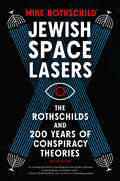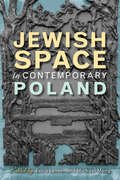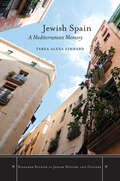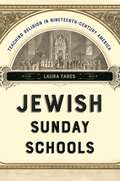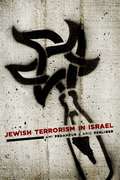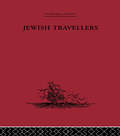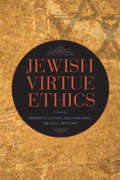- Table View
- List View
Jewish Questions: Responsa on Sephardic Life in the Early Modern Period
by Matt GoldishIn Jewish Questions, Matt Goldish introduces English readers to the history and culture of the Sephardic dispersion through an exploration of forty-three responsa--questions about Jewish law that Jews asked leading rabbis, and the rabbis' responses. The questions along with their rabbinical decisions examine all aspects of Jewish life, including business, family, religious issues, and relations between Jews and non-Jews. Taken together, the responsa constitute an extremely rich source of information about the everyday lives of Sephardic Jews. The book looks at questions asked between 1492--when the Jews were expelled from Spain--and 1750. Originating from all over the Sephardic world, the responsa discuss such diverse topics as the rules of conduct for Ottoman Jewish sea traders, the trials of an ex-husband accused of a robbery, and the rights of a sexually abused wife. Goldish provides a sizeable introduction to the history of the Sephardic diaspora and the nature of responsa literature, as well as a bibliography, historical background for each question, and short biographies of the rabbis involved. Including cases from well-known communities such as Venice, Istanbul, and Saloniki, and lesser-known Jewish enclaves such as Kastoria, Ragusa, and Nablus, Jewish Questions provides a sense of how Sephardic communities were organized, how Jews related to their neighbors, what problems threatened them and their families, and how they understood their relationship to God and the Jewish people.
Jewish Radical Feminism: Voices from the Women's Liberation Movement (Goldstein-Goren American Jewish History #3)
by Joyce AntlerFinalist, 2019 PROSE Award in Biography, given by the Association of American PublishersFifty years after the start of the women’s liberation movement, a book that at last illuminates the profound impact Jewishness and second-wave feminism had on each otherJewish women were undeniably instrumental in shaping the women’s liberation movement of the 1960s, 70s, and 80s. Yet historians and participants themselves have overlooked their contributions as Jews. This has left many vital questions unasked and unanswered—until now. Delving into archival sources and conducting extensive interviews with these fierce pioneers, Joyce Antler has at last broken the silence about the confluence of feminism and Jewish identity.Antler’s exhilarating new book features dozens of compelling biographical narratives that reveal the struggles and achievements of Jewish radical feminists in Chicago, New York and Boston, as well as those who participated in the later, self-consciously identified Jewish feminist movement that fought gender inequities in Jewish religious and secular life. Disproportionately represented in the movement, Jewish women’s liberationists helped to provide theories and models for radical action that were used throughout the United States and abroad. Their articles and books became classics of the movement and led to new initiatives in academia, politics, and grassroots organizing. Other Jewish-identified feminists brought the women’s movement to the Jewish mainstream and Jewish feminism to the Left. For many of these women, feminism in fact served as a “portal” into Judaism.Recovering this deeply hidden history, Jewish Radical Feminism places Jewish women’s activism at the center of feminist and Jewish narratives. The stories of over forty women’s liberationists and identified Jewish feminists—from Shulamith Firestone and Susan Brownmiller to Rabbis Laura Geller and Rebecca Alpert—illustrate how women’s liberation and Jewish feminism unfolded over the course of the lives of an extraordinary cohort of women, profoundly influencing the social, political, and religious revolutions of our era.
Jewish Radicals: A Documentary Reader (Goldstein-Goren Series in American Jewish History #14)
by Tony MichelsWinner of the 2013 New York Book Show Award in Scholarly/Professional Cover DesignJewish Radicals explores the intertwined histories of Jews and the American Left through a rich variety of primary documents. Written in English and Yiddish, these documents reflect the entire spectrum of radical opinion, from anarchism to social democracy, Communism to socialist-Zionism. Rank-and-file activists, organizational leaders, intellectuals, and commentators, from within the Jewish community and beyond, all have their say. Their stories crisscross the Atlantic, spanning from the United States to Europe and British-ruled Palestine.The documents illuminate in fascinating detail the efforts of large numbers of Jews to refashion themselves as they confronted major problems of the twentieth century: poverty, anti-semitism, the meaning of American national identity, war, and totalitarianism. In this comprehensive sourcebook, the story of Jewish radicals over seven decades is told for the first time in their own words.
Jewish Religious Conflicts (Routledge Revivals)
by Maurice SimonFirst published in 1950, Jewish Religious Conflicts gives an account of the principal cleavages that have taken place within the Jewish people since the close of the Old Testament over questions of religious faith, doctrine and practice. While passing in review the chief sects that have formed themselves during that period, it pays particular attention to the most recent cleavages, those between the ‘orthodox’ and ‘reform’, and between the ‘conservative’ and ‘liberal’ movements, which are dividing the Jewish community. This book will be of interest to students of religion and history.
Jewish Religious Music in Nineteenth-Century America: Restoring the Synagogue Soundtrack
by Judah M. CohenThis study of synagogue music in the United States in the second half of the nineteenth century “sets a high standard for historical musicology” (Musica Judaica).In Jewish Religious Music in Nineteenth-Century America: Restoring the Synagogue Soundtrack, Judah M. Cohen demonstrates that Jews constructed a robust religious musical conversation in the United States during the mid- to late-nineteenth century. While previous studies of American Jewish music history have looked to Europe as a source of innovation during this time, Cohen’s careful analysis of primary archival sources tells a different story. Far from seeing a fallow musical landscape, Cohen finds that Central European Jews in the United States spearheaded a major revision of the sounds and traditions of synagogue music during this period of rapid liturgical change.Focusing on the influences of both individuals and texts, Cohen demonstrates how American Jewish musicians sought to balance artistry and group singing, rather than “progressing” from solo chant to choir and organ. Congregations shifted between musical genres and practices during this period in response to such factors as finances, personnel, and communal cohesiveness. Cohen concludes that the “soundtrack” of nineteenth-century Jewish American music heavily shapes how we look at Jewish American music and life in the first part of the twenty-first century, arguing that how we see, and especially hear, history plays a key role in our understanding of the contemporary world around us. Supplemented with an interactive website that includes the primary source materials, recordings of the music discussed, and a map that highlights the movement of key individuals, Cohen’s research defines more clearly the sound of nineteenth-century American Jewry.
Jewish Representation in British Literature 1780–1840
by Michael ScrivenerDescribing Jewish representation bothby Jews and Gentiles in the British Romantic era, Scrivener integrates popular culture with belletristic writing to explore the wildly varying treatments of stereotypical figures: the pedlar, the moneylender, the Jew's daughter, "la belle juive," the convert, the prophet, the alchemist, and the criminal. "
Jewish Resistance to "Romanianization," 1940–44 (Palgrave Studies in the History of Genocide)
by Stefan Cristian IonescuIonescu examines the process of economic Romanianization of Bucharest during the Antonescu regime that targeted the property, jobs, and businesses of local Jews and Roma/Gypsies and their legal resistance strategies to such an unjust policy.
Jewish Rights, National Rites: Nationalism and Autonomy in Late Imperial and Revolutionary Russia
by Simon RabinovitchIn its full-color poster for elections to the All-Russian Jewish Congress in 1917, the Jewish People's Party depicted a variety of Jews in seeking to enlist the support of the broadest possible segment of Russia's Jewish population. It forsook neither traditional religious and economic life like the Jewish socialist parties, nor life in Europe like the Zionists. It embraced Hebrew, Yiddish, and Russian as fulfilling different roles in Jewish life. It sought the democratization of Jewish communal self-government and the creation of new Russian Jewish national-cultural and governmental institutions. Most importantly, the self-named "folkists" believed that Jewish national aspirations could be fulfilled through Jewish autonomy in Russia and Eastern Europe more broadly. Ideologically and organizationally, this party's leadership would profoundly influence the course of Russian Jewish politics. Jewish Rights, National Rights provides a completely new interpretation of the origins of Jewish nationalism in Russia. It argues that Jewish nationalism, and Jewish politics generally, developed in a changing legal environment where the idea that nations had rights was beginning to take hold, and centered on the demand for Jewish autonomy in Eastern Europe. Drawing on numerous archives and libraries in the United States, Russia, Ukraine, and Israel, Simon Rabinovitch carefully reconstructs the political movement for Jewish autonomy, its personalities, institutions, and cultural projects. He explains how Jewish autonomy was realized following the February Revolution of 1917, and for the first time assesses voting patterns in November 1917 to determine the extent of public support for Jewish nationalism at the height of the Russian revolutionary period.
Jewish Salonica: Between the Ottoman Empire and Modern Greece (Stanford Studies In Jewish History And Culture Ser.)
by Devin NaarTouted as the "Jerusalem of the Balkans," the Mediterranean port city of Salonica (Thessaloniki) was once home to the largest Sephardic Jewish community in the world. The collapse of the Ottoman Empire and the city's incorporation into Greece in 1912 provoked a major upheaval that compelled Salonica's Jews to reimagine their community and status as citizens of a nation-state. Jewish Salonica is the first book to tell the story of this tumultuous transition through the voices and perspectives of Salonican Jews as they forged a new place for themselves in Greek society. Devin E. Naar traveled the globe, from New York to Salonica, Jerusalem, and Moscow, to excavate archives once confiscated by the Nazis. Written in Ladino, Greek, French, and Hebrew, these archives, combined with local newspapers, reveal how Salonica's Jews fashioned a new hybrid identity as Hellenic Jews during a period marked by rising nationalism and economic crisis as well as unprecedented Jewish cultural and political vibrancy. Salonica's Jews--Zionists, assimilationists, and socialists--reinvigorated their connection to the city and claimed it as their own until the Holocaust. Through the case of Salonica's Jews, Naar recovers the diverse experiences of a lost religious, linguistic, and national minority at the crossroads of Europe and the Middle East.
Jewish San Francisco (Images of America)
by Edward Zerin Dr Marc DollingerIn San Francisco, the "instant city" of the gold rush days, Jews were pioneers among pioneers. Some came as immigrants directly from Europe, others as resettled adventurers from the East Coast, and still others as scions of southern Sephardic families. Out of this mixed multitude emerged a community with synagogues and institutions to care for the needy and the sick, along with a dignified social fabric. New immigrants following the Russian pogroms of 1883 were absorbed, and the ashen ruins from the 1906 earthquake were rebuilt. The city's cultural treasures and social needs were enriched, and the city's Jews were nurtured by civic commitments. Today's 70,000 San Francisco Jews, standing upon the shoulders of pioneering giants, continue to build and rebuild.
Jewish Self-Defense in South America: Facing Anti-Semitism with a Club in Hand (Routledge Studies in Modern History)
by Raanan ReinJewish Self-Defense in South America charts the ways in which Jewish youth in Argentina and Uruguay organized self-defense groups in the wake of an anti-Semitic wave that swept the Southern Cone in the 1960s. The kidnapping of Nazi war criminal Adolf Eichmann in Buenos Aires in 1960 and his trial and execution in Israel in 1962, as well as the assassination of the Latvian war criminal Herberts Cukurs in Montevideo in 1965, provoked violent attacks by right-wing nationalist organizations against Jewish lives and property. Thousands of Jews decided to teach the anti-Semitic bullies a lesson and make it very clear that shedding Jewish blood would not go unpunished, that Jews were no longer passive victims. The central role that the State of Israel and its envoys played in organizing, instructing, and training self-defense activists highlights the special ties between Israel and the Jewish Diaspora. Based on more than 120 interviews with former activists of self-defense, ex-Mossad officers and veteran Israeli diplomats, as well as on archival research, this is a pioneering study on ethnicity and diaspora in a time of growing political violence in South America. This book is a valuable study for scholars and students researching Jewish history and Latin American history.
Jewish Self-Determination beyond Zionism: Lessons from Hannah Arendt and Other Pariahs
by Jonathan GraubartJewish Self-Determination beyond Zionism examines the liberal Zionist and Jewish anti-Zionist perspectives that developed in the decades following Israeli statehood. In his timely book, Jonathan Graubart. advances a non-statist vision of Jewish self-determination to be realized in a binational political arrangement that rejects Apartheid practices and features a just and collaborative coexistence of Israeli Jews and Palestinian Arabs. The book’s vision advances a distinct Jewish self-determination committed to cultural enrichment and emancipation, internationalism, and the fostering of new political, social, and economic channels for attaining genuine reconciliation between Israelis and Palestinians. Jewish Self-Determination beyond Zionism also engages a Humanist Zionist vision to confront the Zionist movement’s foundational sins and demands a full reckoning with the Palestinians. Graubart focuses on two of Humanist Zionism’s most insightful thinkers, Martin Buber and Hannah Arendt, putting them “in conversation” with each other, and synthesizing their collective insights and critical Jewish perspectives alongside the ideas of Noam Chomsky, Judith Butler, Ella Shohat, Edward Said, and other philosophers and academics. Jewish Self-Determination beyond Zionism concludes that an updated, binational program is the best path forward.
Jewish Self-Determination beyond Zionism: Lessons from Hannah Arendt and Other Pariahs
by Jonathan GraubartJewish Self-Determination beyond Zionism examines the liberal Zionist and Jewish anti-Zionist perspectives that developed in the decades following Israeli statehood. In his timely book, Jonathan Graubart. advances a non-statist vision of Jewish self-determination to be realized in a binational political arrangement that rejects Apartheid practices and features a just and collaborative coexistence of Israeli Jews and Palestinian Arabs. The book’s vision advances a distinct Jewish self-determination committed to cultural enrichment and emancipation, internationalism, and the fostering of new political, social, and economic channels for attaining genuine reconciliation between Israelis and Palestinians. Jewish Self-Determination beyond Zionism also engages a Humanist Zionist vision to confront the Zionist movement’s foundational sins and demands a full reckoning with the Palestinians. Graubart focuses on two of Humanist Zionism’s most insightful thinkers, Martin Buber and Hannah Arendt, putting them “in conversation” with each other, and synthesizing their collective insights and critical Jewish perspectives alongside the ideas of Noam Chomsky, Judith Butler, Ella Shohat, Edward Said, and other philosophers and academics. Jewish Self-Determination beyond Zionism concludes that an updated, binational program is the best path forward.
Jewish Soldiers in the Civil War: The Union Army
by Adam D. MendelsohnOffers an engaging account of the experiences of Jewish soldiers in the Union Army during the Civil WarWhat was it like to be a Jew in Lincoln’s armies? The Union army was as diverse as the embattled nation it sought to preserve, a unique mixture of ethnicities, religions, and identities. Almost one Union soldier in four was born abroad, and natives and newcomers fought side-by-side, sometimes uneasily. Yet though scholars have parsed the trials and triumphs of Irish, Germans, African Americans, and others in the Union ranks, they have remained largely silent on the everyday experiences of the largest non-Christian minority to have served.In ways visible and invisible to their fellow recruits and conscripts, the experience of Jews was distinct from that of other soldiers who served in Lincoln’s armies. Adam D. Mendelsohn draws for the first time upon the vast database of verified listings of Jewish soldiers serving in the Civil War collected by The Shapell Roster, as well as letters, diaries, and newspapers, to examine the collective experience of Jewish soldiers and to recover their voices and stories. The volume examines when and why they decided to enlist, explores their encounters with fellow soldiers, and describes their efforts to create community within the ranks. This monumental undertaking rewrites much of what we think we know about Jewish soldiers during the Civil War.
Jewish Soul (Tango of Death #3)
by Rita KarnoppMayla Sucuri’s world is falling apart . . . no Gypsy is safe in Hitler’s Germany. Her twin sister, Vanya, has just run off with her love and joined the partisans. Now Mayla is being forced to leave her papa and younger sister, Zilka, with the kumpania. Heading to Switzerland with her mother, to the safety of her Grandmother’s chalet in Switzerland, Mayla fears she’ll never see any of them again. Her grandmother is connected to every high official in the SS. But not everything is as it appears. Because of her drive to be a doctor, Mayla finds herself invited to Dachau and Auschwitz. She quickly finds herself in the company of Doctor Josef Mengele and Doctor Sigmund Rascher, who are only too willing to share the results of their medical experiments on Jews and Gypsies. At great personal risk, Mayla refuses to turn down the opportunity to take notes and bear witness to the atrocities happening at the concentration camps. Mayla is drawn to Auschwitz where the distinctions between good and evil become blurred in a world turned upside down. Will it get her killed or will her unwavering resolve give her the strength and courage to rescue her sisters from the gas chambers?
Jewish Souls, Bureaucratic Minds: Jewish Bureaucracy and Policymaking in Late Imperial Russia, 1850-1917
by Vassili SchedrinJewish Souls, Bureaucratic Minds examines the phenomenon of Jewish bureaucracy in the Russian empire—its institutions, personnel, and policies—from 1850 to 1917. In particular, it focuses on the institution of expert Jews, mid-level Jewish bureaucrats who served the Russian state both in the Pale of Settlement and in the central offices of the Ministry of Internal Affairs in St. Petersburg. The main contribution of expert Jews was in the sphere of policymaking and implementation. Unlike the traditional intercession of shtadlanim (Jewish lobbyists) in the high courts of power, expert Jews employed highly routinized bureaucratic procedures, including daily communications with both provincial and central bureaucracies. Vassili Schedrin illustrates how, at the local level, expert Jews advised the state, negotiated power, influenced decisionmaking, and shaped Russian state policy toward the Jews. Schedrin sheds light on the complex interactions between the Russian state, modern Jewish elites, and Jewish communities. Based on extensive new archival data from the former Soviet archives, this book opens a window into the secluded world of Russian bureaucracy where Jews shared policymaking and administrative tasks with their Russian colleagues. The new sources show these Russian Jewish bureaucrats to be full and competent participants in official Russian politics. This book builds upon the work of the original Russian Jewish historians and recent historiographical developments, and seeks to expose and analyze the broader motivations behind official Jewish policy, which were based on the political vision and policymaking contributions of Russian Jewish bureaucrats. Scholars and advanced students of Russian and Jewish history will find Jewish Souls, Bureaucratic Minds to be an important tool in their research.
Jewish South Jersey (Images of America)
by Allen Meyers Leonard F. VernonInitial Jewish settlements in South Jersey emerged in the mid-19th century and offered a safe haven for people to re-create strong families and practice religion freely, without fear of government-sponsored violence. Looking for work, German Jews first migrated from their community in Philadelphia to Trenton, and then spread south to Wildwood. Although Jewish settlers were mainly known as merchants and shop owners, many towns also boast the development of the Jewish farmer. While agriculture would eventually be abandoned in favor of manufacturing, there were many extremely successful and historically significant Jewish farms that flourished in the south. Now, of course, people of the Hebrew faith are productive players in every walk of life. Jewish South Jersey touches on the many contributions made by Jewish people in the southern part of the Garden State.
Jewish Space Lasers: The Rothschilds and 200 Years of Conspiracy Theories
by Mike RothschildWith the current rise of antisemitism, this important book looks at how one Jewish family —the Rothschilds—became a lightning rod for the conspiracy theories of the last two centuries, and how those theories are still very much alive today. In 2018 Congresswoman Marjorie Taylor Greene took to social media to share her suspicions that the California wildfires were started by &‘space solar generators&’ which were funded by powerful, mysterious backers. Instantly, thousands of people rallied around her, blaming the fires on &“Jewish space lasers&” and, ultimately, the Rothschild family. For more than 200 years, the name "Rothschild" has been synonymous with two things: great wealth, and conspiracy theories about what they're "really doing" with it. Almost from the moment Mayer Amschel Rothschild and his sons emerged from the Jewish ghetto of Frankfurt to revolutionize the banking world, the Rothschild family has been the target of myths, hoaxes, bizarre accusations, and constant, virulent antisemitism. Over the years, they have been blamed for everything from the sinking of the Titanic, to causing the Great Depression, and even creating the COVID-19 pandemic. Jewish Space Lasers: The Rothschilds and 200 Years of Conspiracy Theories is a deeply researched dive into the history of the conspiracy industry around the Rothschild family - from the "pamphlet wars" of Paris in the 1840s to the dankest pits of the internet today. Journalist and conspiracy theory expert Mike Rothschild, who isn't related to the family, sorts out myth from reality to find the truth about these conspiracy theories and their spreaders. Who were the Rothschilds? Who are they today? Do they really own $500 trillion and every central bank, in addition to &“controlling the British money supply?&” Is any of this actually true? And why, even as their wealth and influence have waned, do they continue to drive conspiracies and hoaxes?
Jewish Space in Contemporary Poland
by Erica T. Lehrer Michael MengIn a time of national introspection regarding the country's involvement in the persecution of Jews, Poland has begun to reimagine spaces of and for Jewishness in the Polish landscape, not as a form of nostalgia but as a way to encourage the pluralization of contemporary society. The essays in this book explore issues of the restoration, restitution, memorializing, and tourism that have brought present inhabitants into contact with initiatives to revive Jewish sites. They reveal that an emergent Jewish presence in both urban and rural landscapes exists in conflict and collaboration with other remembered minorities, engaging in complex negotiations with local, regional, national, and international groups and interests. With its emphasis on spaces and built environments, this volume illuminates the role of the material world in the complex encounter with the Jewish past in contemporary Poland.
Jewish Spain: A Mediterranean Memory
by Tabea Alexa LinhardWhat is meant by "Jewish Spain"? The term itself encompasses a series of historical contradictions. No single part of Spain has ever been entirely Jewish. Yet discourses about Jews informed debates on Spanish identity formation long after their 1492 expulsion. The Mediterranean world witnessed a renewed interest in Spanish-speaking Jews in the twentieth century, and it has grappled with shifting attitudes on what it meant to be Jewish and Spanish throughout the century. At the heart of this book are explorations of the contradictions that appear in different forms of cultural memory: literary texts, memoirs, oral histories, biographies, films, and heritage tourism packages. Tabea Alexa Linhard identifies depictions of the difficulties Jews faced in Spain and Northern Morocco in years past as integral to the survival strategies of Spanish Jews, who used them to make sense of the confusing and harrowing circumstances of the Spanish Civil War, the Francoist repression, and World War Two. Jewish Spain takes its place among other works on Muslims, Christians, and Jews by providing a comprehensive analysis of Jewish culture and presence in twentieth-century Spain, reminding us that it is impossible to understand and articulate what Spain was, is, and will be without taking into account both "Muslim Spain" and "Jewish Spain."
Jewish Studies at the Crossroads of Anthropology and History: Authority, Diaspora, Tradition (Jewish Culture and Contexts)
by Marina Rustow Ra‘anan S. Boustan Oren KosanskyOver the past several decades, the field of Jewish studies has expanded to encompass an unprecedented range of research topics, historical periods, geographic regions, and analytical approaches. Yet there have been few systematic efforts to trace these developments, to consider their implications, and to generate new concepts appropriate to a more inclusive view of Jewish culture and society. Jewish Studies at the Crossroads of Anthropology and History brings together scholars in anthropology, history, religious studies, comparative literature, and other fields to chart new directions in Jewish studies across the disciplines.This groundbreaking volume explores forms of Jewish experience that span the period from antiquity to the present and encompass a wide range of textual, ritual, spatial, and visual materials. The essays give full consideration to non-written expressions of ritual performance, artistic production, spoken narrative, and social experience through which Jewish life emerges. More than simply contributing to an appreciation of Jewish diversity, the contributors devote their attention to three key concepts—authority, diaspora, and tradition—that have long been central to the study of Jews and Judaism. Moving beyond inherited approaches and conventional academic boundaries, the volume reconsiders these core concepts, reorienting our understanding of the dynamic relationships between text and practice, and continuity and change in Jewish contexts. More broadly, this volume furthers conversation across the disciplines by using Judaic studies to provoke inquiry into theoretical problems in a range of other areas.
Jewish Sunday Schools: Teaching Religion in Nineteenth-Century America (North American Religions #22)
by Laura Yares73rd National Jewish Book Awards FinalistCharts how changes to Jewish education in the nineteenth century served as a site for the wholescale reimagining of Judaism itselfThe earliest Jewish Sunday schools were female-led, growing from one school in Philadelphia established by Rebecca Gratz in 1838 to an entire system that educated vast numbers of Jewish youth across the country. These schools were modeled on Christian approaches to religious education and aimed to protect Jewish children from Protestant missionaries. But debates soon swirled around the so-called sorry state of “feminized” American Jewish supplemental learning, and the schools were taken over by men within one generation of their creation. It is commonly assumed that the critiques were accurate and that the early Jewish Sunday school was too feminized, saccharine, and dependent on Christian paradigms. Tracing the development of these schools from their inception through the first decade of the twentieth century, this book shows this was not the reality.Jewish Sunday Schools argues that the work of the women who shepherded Jewish education in the early Jewish Sunday school had ramifications far outside the classroom. Indeed, we cannot understand the nineteenth-century American Jewish experience, and how American Judaism sought to sustain itself in an overwhelmingly Protestant context, without looking closely at the development of these precursors to Hebrew School.Jewish Sunday Schools provides an in-depth portrait of a massively understudied movement that acted as a vital means by which American Jews explored and reconciled their religious and national identities.
Jewish Terrorism in Israel (Columbia Studies in Terrorism and Irregular Warfare)
by Ami Pedahzur Arie PerligerAmi Pedahzur and Arie Perliger, world experts on the study of terror and security, propose a theory of violence that contextualizes not only recent acts of terror but also instances of terrorism that stretch back centuries. Beginning with ancient Palestine and its encounters with Jewish terrorism, the authors analyze the social, political, and cultural factors that sponsor extreme violence, proving religious terrorism is not the fault of one faith, but flourishes within any counterculture that adheres to a totalistic ideology.When a totalistic community perceives an external threat, the connectivity of the group and the rhetoric of its leaders bolster the collective mindset of members, who respond with violence. In ancient times, the Jewish sicarii of Judea carried out stealth assassinations against their Roman occupiers. In the mid-twentieth century, to facilitate their independence, Jewish groups committed acts of terror against British soldiers and the Arab population in Palestine. More recently, Yigal Amir, a member of a Jewish terrorist cell, assassinated Yitzhak Rabin to express his opposition to the Oslo Peace Accords. Conducting interviews with former Jewish terrorists, political and spiritual leaders, and law-enforcement officials, and culling information from rare documents and surveys of terrorist networks, Pedahzur and Perliger construct an extensive portrait of terrorist aggression, while also describing the conditions behind the modern rise of zealotry.
Jewish Travellers
by Elkan Nathan AdlerFirst published in 1930. The wandering Jew is a very real character in the great drama of history. He has travelled as nomad and settler, as fugitive and conqueror, as exile and colonist and as merchant and scholar. Of necessity bilingual and therefore the master of many languages, the Jew was the ideal commercial traveller and interpreter.Based on the volume of 24 Hebrew texts of Jewish travellers by J D Eisenstein, this volume begins with the ninth century. After the sixteenth century geographical discoveries had made the whole world familiar to most people. Consequently, the wandering Jew becomes less the diplomatist or scientist but still remains a link between the scattered members of the Diaspora. The volume ends in the middle of the eighteenth century and taken as a whole provides a survey of Jewish travel during the Middle Ages. For this translation, some of the texts have been abridged, whilst retaining many of the original notes.
Jewish Virtue Ethics (SUNY series in Contemporary Jewish Thought)
by Geoffrey D. Claussen; Alexander Green; Alan L. MittlemanWhat is good character? What are the traits of a good person? How should virtues be cultivated? How should vices be avoided? The history of Jewish literature is filled with reflection on questions of character and virtue such as these, reflecting a wide range of contexts and influences. Beginning with the Bible and culminating with twenty-first-century feminism and environmentalism, Jewish Virtue Ethics explores thirty-five influential Jewish approaches to character and virtue.Virtue ethics has been a burgeoning field of moral inquiry among academic philosophers in the postwar period. Although Jewish ethics has also flourished as an academic (and practical) field, attention to the role of virtue in Jewish thought has been underdeveloped. This volume seeks to illuminate its centrality not only for readers primarily interested in Jewish ethics but also for readers who take other approaches to virtue ethics, including within the Western virtue ethics tradition. The original essays written for this volume provide valuable sources for philosophical reflection.
